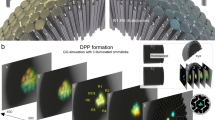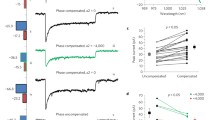Summary
Except for very special fused rhabdoms, e. g. those with orthogonal microvilli like the worker bee, the direction of the electric vector E of linear polarized light necessary for a maximum response from a retinula cell is not parallel (or perpendicular) to the microvilli of the recorded cell.
This is because the rhabdomeres of a fused rhabdom are optically coupled, i. e. the properties of each rhabdomere influence the manner in which light is transmitted down the composite rhabdom structure.
A rhabdom is analogous to a non-uniform absorbing optical crystal. Such a crystal has two coordinate (optical) axes along which E remains linear polarized as it propagates. Only when the microvilli of the recorded cell are parallel to one of these axes will the direction ofE for maximum retinula cell response be parallel to the microvilli.
The locust-type of rhabdom is used as an example.
Similar content being viewed by others
References
Born, M., Wolf, E.L.: Principles of optics, chap. 7. New York: Pergamon Press 1965.
Horridge, G.A.: The retina of the locust. In: The functional organization of the compound eye, C. G. Bernhard, Ed. Oxford: Pergamon Press 1966.
Kirschfeld, K.: Absorption properties of photopigments in single rods, cones and rhabdoms. In: Processing of optical data by organism and by machines. New York: Academic Press 1969.
Seitz, G.: Polarisationsoptische Untersuchungen am Auge vonCalliphora erythocephale (Meig.). Z. Zellforsch.93, 525–529 (1969).
Shaw, S.R.: Interreceptor coupling in ommatidia of drone honeybee and locust compound eyes. Vision Res.9, 999–1029 (1969a).
Shaw, S.R.: Sense cell structure and interspecies comparisons of polarized light absorption in arthropod compound eyes. Vision Res.9, 1031–1041 (1969b).
Snyder, A. W.: Polarization sensitivity of individual retinula cells, J. comp. Physiol.83, 331–360 (1973a).
Snyder, A. W.: Light absorption in visual photoreceptors. J. opt. Soc. Amer. (submitted) (1973b).
Snyder, A.W., Menzel, R., Laughlin, S.B.: Polarization and spectral sensitivity of retinula cells of a fused rhabdom — consequences of optical and electrical coupling. J. comp. Physiol. (to be submitted).
Weale, R.A.: On the birefringence of rods and cones. Pflügers Arch.329, 244–257 (1971).
Author information
Authors and Affiliations
Rights and permissions
About this article
Cite this article
Snyder, A.W., Sammut, R. Direction ofE for maximum response of a retinula cell. J. Comp. Physiol. 85, 37–45 (1973). https://doi.org/10.1007/BF00694139
Received:
Issue Date:
DOI: https://doi.org/10.1007/BF00694139




